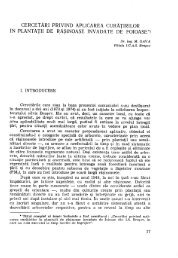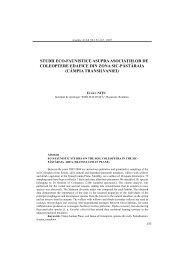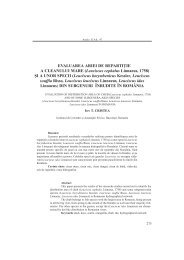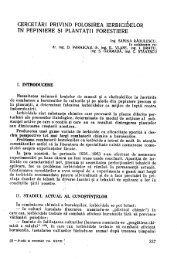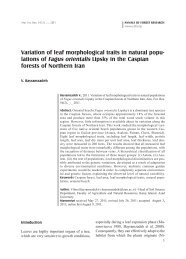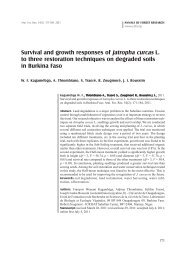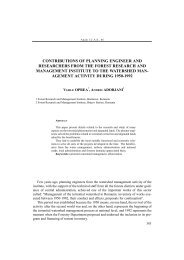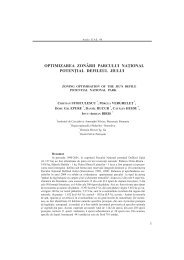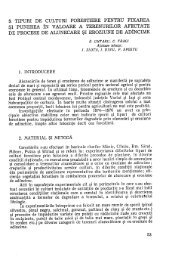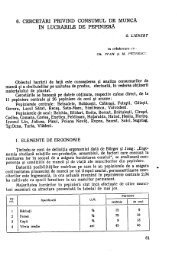Ann. For. Res. 54(1): 57-71, 2011wetter <st<strong>ro</strong>ng>and</st<strong>ro</strong>ng> milder during the winter. In South,climate is temperate continental, with p<strong>ro</strong>nouncedtemperature extremes <st<strong>ro</strong>ng>and</st<strong>ro</strong>ng> p<strong>ro</strong>longedd<strong>ro</strong>ught during the summer months. Southernforest st<st<strong>ro</strong>ng>and</st<strong>ro</strong>ng>s are located in plains, frequentlyexposed to summer d<strong>ro</strong>ught (Giurgiu - MihaiBravu, Brneti, Vlsia - Buriau, ExperimentalStation tefneti, Brgan, Vldiceasca,Slveti, Snagov, Comana). Comana <st<strong>ro</strong>ng>and</st<strong>ro</strong>ng> MihaiBravu are located an the Neajlov riverdelta. The st<st<strong>ro</strong>ng>and</st<strong>ro</strong>ng> age varied between 60 <st<strong>ro</strong>ng>and</st<strong>ro</strong>ng> 90years.Stressful conditions affecting the trees f<strong>ro</strong>mdifferent investigated locations were assignedto g<strong>ro</strong>ups: (i) soil pollution f<strong>ro</strong>m an oil extractionplant (Tinca), (ii) several years of recurringd<strong>ro</strong>ught (Brgan), (iii) multiple sourcesof city pollution in the city of Oradea, (iv)ch<strong>ro</strong>nic foliar disease p<strong>ro</strong>duced by ErysipheResearch articlesalphitoides (Griffon & Maubl.) U.Braun &S.Takam <st<strong>ro</strong>ng>and</st<strong>ro</strong>ng> infestations p<strong>ro</strong>duced by gall insects-Dryomyiacircinans (Giraud) (Dobreti)<st<strong>ro</strong>ng>and</st<strong>ro</strong>ng> Cynips quercus-folii (Linnaeus) (Oradea),(v) defoliations p<strong>ro</strong>duced mainly by Lymantriadispar (Linnaeus) (Tinca).Root p<strong>ro</strong>cessing p<strong>ro</strong>tocol. Mycorrhizalsystem is dened as a lateral ramication <st<strong>ro</strong>ng>and</st<strong>ro</strong>ng>all its tributary apices f<strong>ro</strong>m a sustaining suberi-ed <strong>ro</strong>ot, total length varying between 1 <st<strong>ro</strong>ng>and</st<strong>ro</strong>ng> 5cm. During the research mycorrhizal <strong>ro</strong>ot systemswere studied according to this denition,pieces of 10-20 mm being cut <st<strong>ro</strong>ng>and</st<strong>ro</strong>ng> investigatedfor alive <st<strong>ro</strong>ng>and</st<strong>ro</strong>ng> declining mycorrhizal apices.Blocks of soil of 5 x 5 x 5 cm were excavatedin the rhizosphere of selected tree hostspecies (<st<strong>ro</strong>ng>Quercus</st<strong>ro</strong>ng> spp.), in the area of horizontalc<strong>ro</strong>wn p<strong>ro</strong>jection, three trees of the samespecies per st<st<strong>ro</strong>ng>and</st<strong>ro</strong>ng>. The blocks were wrapped1614121086420qcaqcbqcbaqcdqcmbqcoqcsNumber of morphotypesqcslqctqcvqcvlqfaqfdqfgqfmbqfslqftFigure 1 Number of mycorrhizal morphotypes by host (<st<strong>ro</strong>ng>Quercus</st<strong>ro</strong>ng> <st<strong>ro</strong>ng>cerris</st<strong>ro</strong>ng>, Q. <st<strong>ro</strong>ng>frainetto</st<strong>ro</strong>ng>, Q. <st<strong>ro</strong>ng><strong>ro</strong>bur</st<strong>ro</strong>ng>) <st<strong>ro</strong>ng>and</st<strong>ro</strong>ng> locationNotation: qca - <st<strong>ro</strong>ng>Quercus</st<strong>ro</strong>ng> <st<strong>ro</strong>ng>cerris</st<strong>ro</strong>ng>, Arad; qcbr - <st<strong>ro</strong>ng>Quercus</st<strong>ro</strong>ng> <st<strong>ro</strong>ng>cerris</st<strong>ro</strong>ng>, Brgan; qcba - <st<strong>ro</strong>ng>Quercus</st<strong>ro</strong>ng> <st<strong>ro</strong>ng>cerris</st<strong>ro</strong>ng>, Bneasa; qcd- <st<strong>ro</strong>ng>Quercus</st<strong>ro</strong>ng> <st<strong>ro</strong>ng>cerris</st<strong>ro</strong>ng>, Dobreti; qcmb - <st<strong>ro</strong>ng>Quercus</st<strong>ro</strong>ng> <st<strong>ro</strong>ng>cerris</st<strong>ro</strong>ng>, Mihai Bravu, qco - <st<strong>ro</strong>ng>Quercus</st<strong>ro</strong>ng> <st<strong>ro</strong>ng>cerris</st<strong>ro</strong>ng>, F.D. Oradea, qcsl -64Host species<st<strong>ro</strong>ng>Quercus</st<strong>ro</strong>ng> <st<strong>ro</strong>ng>cerris</st<strong>ro</strong>ng>, Slveti; qcs - <st<strong>ro</strong>ng>Quercus</st<strong>ro</strong>ng> <st<strong>ro</strong>ng>cerris</st<strong>ro</strong>ng>, tefneti; qct - <st<strong>ro</strong>ng>Quercus</st<strong>ro</strong>ng> <st<strong>ro</strong>ng>cerris</st<strong>ro</strong>ng>, Tinca; qcv - <st<strong>ro</strong>ng>Quercus</st<strong>ro</strong>ng> <st<strong>ro</strong>ng>cerris</st<strong>ro</strong>ng>,Vldiceasca; qcvl - <st<strong>ro</strong>ng>Quercus</st<strong>ro</strong>ng> <st<strong>ro</strong>ng>cerris</st<strong>ro</strong>ng>, Vlsia; qfa - <st<strong>ro</strong>ng>Quercus</st<strong>ro</strong>ng> <st<strong>ro</strong>ng>frainetto</st<strong>ro</strong>ng>, Arad (Radna); qfd- <st<strong>ro</strong>ng>Quercus</st<strong>ro</strong>ng> <st<strong>ro</strong>ng>frainetto</st<strong>ro</strong>ng>,Dobreti; qfg - <st<strong>ro</strong>ng>Quercus</st<strong>ro</strong>ng> <st<strong>ro</strong>ng>frainetto</st<strong>ro</strong>ng>, F.D. Giurgiu (Comana); qfmb - <st<strong>ro</strong>ng>Quercus</st<strong>ro</strong>ng> <st<strong>ro</strong>ng>frainetto</st<strong>ro</strong>ng>, Mihai Bravu; qfsl -<st<strong>ro</strong>ng>Quercus</st<strong>ro</strong>ng> <st<strong>ro</strong>ng>frainetto</st<strong>ro</strong>ng>, Slveti; qft - <st<strong>ro</strong>ng>Quercus</st<strong>ro</strong>ng> <st<strong>ro</strong>ng>frainetto</st<strong>ro</strong>ng>, Tinca; qrb - <st<strong>ro</strong>ng>Quercus</st<strong>ro</strong>ng> <st<strong>ro</strong>ng><strong>ro</strong>bur</st<strong>ro</strong>ng>, Buteni; q<strong>ro</strong> - <st<strong>ro</strong>ng>Quercus</st<strong>ro</strong>ng> <st<strong>ro</strong>ng><strong>ro</strong>bur</st<strong>ro</strong>ng>,city of Oradea; qcb - <st<strong>ro</strong>ng>Quercus</st<strong>ro</strong>ng> <st<strong>ro</strong>ng>cerris</st<strong>ro</strong>ng>, Buteni.
Fodor et al. Mycorrhizal status of several <st<strong>ro</strong>ng>Quercus</st<strong>ro</strong>ng> species in <st<strong>ro</strong>ng>Romania</st<strong>ro</strong>ng> ...Table 3 P<strong>ro</strong>portion of mycorrhizal apices in <strong>ro</strong>ot samples (15 mycorrhizal systems selected at r<st<strong>ro</strong>ng>and</st<strong>ro</strong>ng>om) collected during the vegetation season f<strong>ro</strong>m several <st<strong>ro</strong>ng>Quercus</st<strong>ro</strong>ng> species, different locations (1996-2001)Tree species, location <st<strong>ro</strong>ng>and</st<strong>ro</strong>ng> date P<strong>ro</strong>portion of mycorrhizal apices (%)Q. <st<strong>ro</strong>ng>cerris</st<strong>ro</strong>ng>, tefneti (08.1996) 43.5Q. <st<strong>ro</strong>ng>cerris</st<strong>ro</strong>ng>, Mihai Bravu (10.1996) 42.0Q. <st<strong>ro</strong>ng>cerris</st<strong>ro</strong>ng>, Brganu (10.1996) 85.0Q. <st<strong>ro</strong>ng>frainetto</st<strong>ro</strong>ng>, Comana (10.1996) 86.0Q. <st<strong>ro</strong>ng>cerris</st<strong>ro</strong>ng>, Tinca (10.1997) 20.0Q. <st<strong>ro</strong>ng>frainetto</st<strong>ro</strong>ng>, Radna (10.1998) 30.0Q. <st<strong>ro</strong>ng>frainetto</st<strong>ro</strong>ng>, Tinca (09.1998) 32.4Q. <st<strong>ro</strong>ng>cerris</st<strong>ro</strong>ng>, Tinca (09.1998) 31.4Q. <st<strong>ro</strong>ng>frainetto</st<strong>ro</strong>ng>, Mihai Bravu (10.1996) 46.0Q. <st<strong>ro</strong>ng>cerris</st<strong>ro</strong>ng>, Dobreti (07.1998) 46.3Q. <st<strong>ro</strong>ng>frainetto</st<strong>ro</strong>ng>, Dobreti (09.1998) 13.1Q. <st<strong>ro</strong>ng>cerris</st<strong>ro</strong>ng>, Dobreti (07.1998) 67.6Q. <st<strong>ro</strong>ng>cerris</st<strong>ro</strong>ng>, Oradea (09.1998) 67.6Q. <st<strong>ro</strong>ng><strong>ro</strong>bur</st<strong>ro</strong>ng>, Buteni (07.2000) 78.0Q. <st<strong>ro</strong>ng><strong>ro</strong>bur</st<strong>ro</strong>ng>, city of Oradea (06. 2001) 33.0in paper <st<strong>ro</strong>ng>and</st<strong>ro</strong>ng> b<strong>ro</strong>ught to the laboratory. Thesamples, corresponding to one tree mergedin one composite sample subjected to furtherp<strong>ro</strong>cessing. Roots were carefully washed intap water using sieves, placed in Petri dishesof 9 cm <st<strong>ro</strong>ng>and</st<strong>ro</strong>ng> observed under stereomic<strong>ro</strong>scopecleaning meanwhile the adhered soil with nebrushes <st<strong>ro</strong>ng>and</st<strong>ro</strong>ng> needles. The descriptions of themorphotypes are based on mac<strong>ro</strong>scopic charactersfollowing the adapted p<strong>ro</strong>tocol afterAgerer (1987-2002). Actual mycorrhizas wereconrmed mic<strong>ro</strong>scopically by the existence ofthe Hartig net <st<strong>ro</strong>ng>and</st<strong>ro</strong>ng> mycorrhizal mantle (Nylundet al., 1982).Quantitative analysis. Comparison ofthe mycorrhizal status (relative frequencies ofactive mycorrhizal apices) in 5 <strong>ro</strong>ot samplestaken f<strong>ro</strong>m <st<strong>ro</strong>ng>Quercus</st<strong>ro</strong>ng> <st<strong>ro</strong>ng>cerris</st<strong>ro</strong>ng> at Dobreti wasperformed by means of One-Way ANOVA. Aprevious test of variance homogeneity (Bartlett)conrmed the lack of signicant differenceswith respect to the variances amongsamples. Also Tukey test of pair-wise multiplecomparisons was performed in order to detectany signicant differences in mycorrhizationfrequency in the 5 samples set collected f<strong>ro</strong>m<st<strong>ro</strong>ng>Quercus</st<strong>ro</strong>ng> <st<strong>ro</strong>ng>cerris</st<strong>ro</strong>ng> <strong>ro</strong>ots at Dobreti. This locationwas selected to perform the specied statisticalanalyses due to the fact that it corresponds tothe highest diversity of morphotypes found atany location, at a particular moment.The association status of different morphotypeswith Coenococcum geophilum Fr., mostfrequently encountered morphotype, was assessedusing Yule coefcient of association.Yule’s Q coefcient of association is a symmetricmeasure, based on the difference betweenconcordant (meaning both absences a,<st<strong>ro</strong>ng>and</st<strong>ro</strong>ng> both presences, d) <st<strong>ro</strong>ng>and</st<strong>ro</strong>ng> discordant (meaningabsence-presence data, b <st<strong>ro</strong>ng>and</st<strong>ro</strong>ng> presence-absencedata, c) data pairs (Singh, 2004).Q = (ad-bc)/(cd+bc)The coefcient takes values between -1 <st<strong>ro</strong>ng>and</st<strong>ro</strong>ng>1: -1 corresponds to a complete exclusion ofthe species, 0 corresponds to r<st<strong>ro</strong>ng>and</st<strong>ro</strong>ng>om associations<st<strong>ro</strong>ng>and</st<strong>ro</strong>ng> 1 to constant associations. Q statisticdenes null relationship as statistical independence.Hierarchical cluster analysis of tree species<st<strong>ro</strong>ng>and</st<strong>ro</strong>ng> locations, with regard to mycorrhizal morphotypes,was performed after the calculationof the Sørensen similarity index. The similar-65



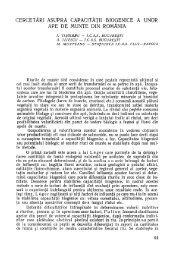
![studiu privind conditiilb] de vegetatie ale ... - EdituraSilvica.ro](https://img.yumpu.com/50877313/1/175x260/studiu-privind-conditiilb-de-vegetatie-ale-editurasilvicaro.jpg?quality=85)

